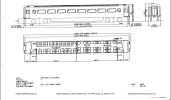After a day offline it is a return to action for the evocative subject of the type 2s era in the Highlands.
Although the topic subject is the 1980s, part of the discussion has been around type2s which by the 1980s were on the way out as traction on these routes
There has been mention of maximum loads in passenger service and quite rightly include 1970s examples of load 9 to the Far North and to quote
@D6130 'eight-and-a-half' on the 06.00 from Queen St.
Timing loads were typically calculated as number of coaches x 35, 35 being an average weight for a Mk1 coach (excluding sleepers and diners), with individual weights generally between 33 and 37 tons, the heavier examples being those fitted with commonwealth bogies. sleepers and diners being around 5t heavier.
Thus although the 06.00 was 'eight-and-a-half', in weight terms it was nine, an extra 5 tons each for the RB, SLF and SLS, and 17t (Wiki) for the PMV or CCT. Strangely although the 73/74 Marshalling book states the load as '9/314', the footnotes state '
must not exceed 9 vehicles/300 tons'. By 76/77 this had been amended to '
must not exceed 9 vehicles leaving Glasgow' followed by '(
315t Timing Load)'. As stated above most other West Highland trains were max load 8 /280 although a couple of trains were 7/245, including the 16.38 from Queen St which was 14 minutes faster to Fort William than the 06.00 reflecting faster acceleration and climbing.
@D6130 notes a 1973 instance of a 9 coach excursion, and ten years earlier the ill fated 'Jacobite' promoted as the 'last steam train on the West Highland' formed of 9 coaches returned from Mallaig behind a single class 27 throughout leaving a trail of failed steam locos in behind. Also, I have noted in a previous thread an August 1978 instance where a single class 27 went forward from Corrour with load 11 following two class 27 failures, whilst this would undoubtedly lose time in acceleration and on the climbs to County March and Glen Douglas summits, the load of just over 400t was within the known capabilities of a class 27 as it was slightly less than the maximum load for a class 27 on freight.
I suspect the 9 max. reflected the need to have the van platformed for loading at Queen St, it was off the platform at most stations and only conveyed traffic for Crianlarich and Fort William, intermediate and Mallaig line traffic being in the two BSKs and there was no scope to strengthen this train (see Summer Sats below). In the same era the Sunday 18.10 to Aberdeen was booked load 10 with the leading TSO off the platform at Queen St and slightly later the Sunday 08.10 to Aberdeen acquired an Inverness portion and was load 11, proving Queen St could handle longer trains albeit there was only the hourly Edinburgh plus occasional Aberdeen/Dundee or Inverness trains on a Sunday at Queen St in that era.
In Kings Cross days the London portion to Fort William was BCK SLF SLS - i.e. seated coach next to the van at the front, but once the transfer to Euston had taken place it became SLF SLS SK or TSO BCK (sleepers next to the van) meaning one of the BSKs had to be dropped from the Glasgow portion to maintain length and weight. Once the RB had been replaced by an RMB, and the ScR had received an allocation of BFKs, BSK,CK, RB were replaced by BFK RMB reducing the load to 8 with similar seating capacity..
On Summer Saturdays there were two additional SLS and an additional TSO from Kings Cross meaning the portion had to run independently from Edinburgh (03.45) to Fort William (and the 06.00 could be strengthened by 1 TSO), and this practice continued in the early Euston years (extra 2 SLS but no extra TSO) with the usual 04.22 Mossend to Queen St becoming 04.22 Mossend to Fort William. It is also worth noting in the 60's the Kings X portion ran independently from Edinburgh at 03.45 every day although with only a single coach added at Edinburgh as strenthening.
Southbound the summer Sats strengthening resulted in an 11 coach formation from Fort William (I do recall seeing it with 12 on at least one occasion), and was routed via Glasgow Queen St Low Level thence via Springburn on to Edinburgh - when running to Euston that portion was detached at Cowlairs on the way into Queen St High Level, and summer strengthen from (Fri night) and to (Sat) Euston ceased in the late 1970s.
Having dealt with the West Highland (no doubt in too much detail for some) I will return with some (briefer) notes re Kyle and Far North workings when time permits this afternoon.


 ), and as there weren't any original Mk2 BFK built, it was necessary to provide a full FK, alias empty stock back and forth all day for the service. Actually it wasn't always empty, for in the 1970s there were a number of Scotrail management grades with first class passes, for whom the FK formed a sort of private club when commuting, as a number did between the cities, whilst there were standees in standard.
), and as there weren't any original Mk2 BFK built, it was necessary to provide a full FK, alias empty stock back and forth all day for the service. Actually it wasn't always empty, for in the 1970s there were a number of Scotrail management grades with first class passes, for whom the FK formed a sort of private club when commuting, as a number did between the cities, whilst there were standees in standard.